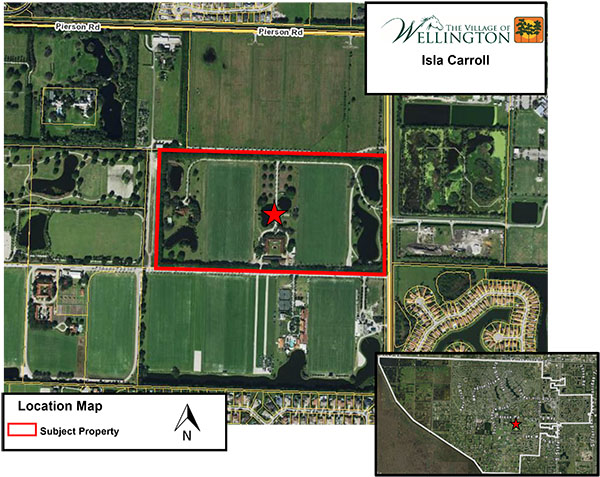Backers of the Isla Carroll project in Wellington’s equestrian area have withdrawn their application, with mention of a prospective resubmission at some point in the future. The project called for 40 homes on 79 acres, with many of them on lots of a third of an acre.
“Our project team received thoughtful feedback during the initial review of our application,” said Jessica Sause, senior vice president of communications for McCourt Partners in a statement Tuesday, March 4. “Our goal has always been to create a project that reflects and enhances the unique character of Wellington’s equestrian community. With that in mind, we are refining our plans to further celebrate the equestrian lifestyle and look forward to continuing our conversations with the community when we file our updated application.”
The project to create an equestrian-themed community and club was originally expected to come back before Wellington’s Planning, Zoning & Adjustment Board (PZAB) at its meeting Wednesday, Feb. 19, but it became apparent a change of course was underway.
“Their agent indicated that they are doing a reworking, and it may be coming back with a completely revised application and want to restart from the beginning,” Planning, Zoning & Building Director Tim Stillings said at the meeting.
In response to a question, Stillings said that would likely mean the renewed application would start again before the Equestrian Preserve Committee, which recommended against the initial plan 7-0.
The PZAB voted in January to accept a postponement requested by the applicant. That followed questions from board members about whether the proposal for “clustered” housing was appropriate for the location, in the heart of Wellington’s equestrian area.
A big question raised in the debate: Whether 35 of the lots will in effect be removed from the Equestrian Preserve Area, even if not legally or formally so, because future buyers or repurchasers don’t have room to put stables, in contrast to what are typically multi-acre lots in the preserve.
The voting by advisory boards is meant as a recommendation for the Wellington Village Council, though ultimately it is not binding on the council’s final vote.
Isla Carroll’s pitch was for an equestrian-themed club community near 120th Avenue South and Pierson Road to serve as an “incubator” for prosperous newcomers to become exposed to a balmy citadel of the horse world.
Five lots would have been at least 1.5 acres, big enough for stables if slightly short of a two-acre standard applying in many parts of the area, while the rest would have constituted much smaller parcels. Buyers and up to a total of 300 club members would have access to a community barn, 24 stalls, riding rings, a gym, pools, racket sports and other amenities.
In the big picture, builders argued, it did fit because it amounted to 40 homes on 79 acres, close to the two-acre standard.
Development pitches are coming under close scrutiny after a 4-1 council vote in February 2024 for a plan from Wellington Lifestyle Partners, backed by equestrian businessman Mark Bellissimo. That removed 96 acres from the Equestrian Preserve Area for the first time in village history, citing a consolidated and improved showgrounds as justification to construct 203 luxury residences, a hotel, shops and restaurants.
Important players figure in the process. The McCourt firm was founded by Frank McCourt, former Los Angeles Dodgers owner, billionaire, Wellington property owner and equestrian enthusiast.
In other action, the zoning board unanimously approved land-use changes to accommodate a mix of residences, restaurants, shops and a school on Wellington’s K-Park property, though some members expressed concern about wiggle room to let developers buy their way out of conventional requirements for green and civic space.
PZAB Member Elizabeth Mariaca asked about language that, as she reads it, calls for builders to provide a park or make payments instead.
“Can we get rid of that ‘in lieu of payments’ and make it so it’s ‘provide a park?’” Mariaca asked.
“Absolutely, we can look at that,” Stillings said. “It becomes a bit of a challenge to incorporate that.”
Existing rules were designed with projects in mind like the Olympia and Black Diamond communities, with freestanding houses on an overall large parcel of land, he said.
This one deals with denser residences, including townhomes and apartments, mixed with other offerings in a relatively smaller space.
Say the project wants to build 500 rental residences. Based on calculations of about 1,500 people living there, that could call for 7.5 acres of park land and 1.5 acres of civic land, he said.
That could pose difficulties making everything fit comfortably for a project on about 69 acres, with a western end holding a new private school.
“This is acres they would have to carve out of their development,” Stillings said. “The ‘in lieu,’ what it does is it says, ‘OK, if you can’t accommodate this on your site, you’re going to give us funds equivalent to what it would cost to buy that property.”
Mariaca replied, “I understand. I just think long term, we would want to encourage green space.”
Recent projects, such as Lotis Wellington, have provided a negotiated blend of park amenities, in some cases where privately owned land is made available for public use, but the village does not have to maintain it, Stillings said.
In a separate issue, there has been talk about preserving an existing 2.5-acre pond on the K-Park site, though that does not quite come with a guarantee either.
“I think they’re going to use it as a design element, at least if they keep it on site,” Stillings said. “There still is an option that they would relocate it, so they’re weighing those options.”
It’s a reclaimed water storage pool, which is replenished by the village, so it stands at less risk of drying up in stretches with little rain, he said. Final details might not be revealed until specific development requests come in.
Developer Related Ross did not respond to a request for comment, but the company has emphasized through the process that it wants a walkable, comfortable community with green and community spaces as a selling point.
“The project will create a vibrant retail and dining-focused community gathering place, enhance green spaces, provide new residences and establish a world-class, not-for-profit private school at the heart of Wellington,” Related Ross President Kenneth A. Himmel said after the council voted to support the $47 million land sale in January.
Wellington plans to sell the K-Park land to Related Ross and an educational partner in a deal that remains contingent on approvals for particular development plans over the next 18 months to two years.
PZAB Member Stacy Lima wondered if regulations going forward could better prioritize preserving natural features, as well as incorporating issues like walkability or connecting with mass transit. She mentioned light rail, if a line linking the western communities to the coast ever came about, for instance.
Such transit issues are bigger than Wellington alone, but village officials are studying ways to connect to regional proposals such as light rail, Stillings said.
In the end, the planning board voted 7-0 to amend the future land use map for K-Park in the village’s comprehensive plan from “community facilities” to “mixed use.” The change was initiated by the village, not the developer.
“Whether or not this purchase and sale agreement with Related were to go forward, I believe the vision for the property is a mix of uses,” Stillings said.
“That’s why the village chose to initiate this land-use change.”








